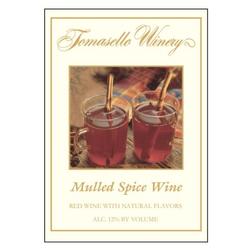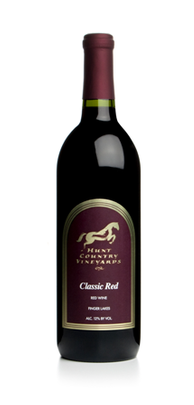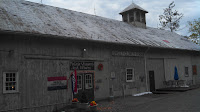Tis the season for all the major food websites to break out their mulled wine recipes. Never heard of that style? Well, according to
wiki:
Mulled wine (otherwise known as Glögg or Gløgg) is a beverage that ranges from alcoholic to non-alcoholic. It is usually made with red wine along with various spices and raisins, served hot or warm. It is a traditional drink during winter, especially around Christmas and Halloween.

Being lazy, out household takes the easy route and purchases mulled wine from local wineries - then fortify it with our favorite rum. Here's a few we have enjoyed in the past and some we are seeking this year (including the winery's tasting notes):
Burnley Vineyards (VA) -
Spicy Rivanna ($12)
This is our Rivanna Red to which we have added cinnamon, clove, nutmeg,
allspice, anise, orange peel, lemon peel and residual sugar. This wine
is best served either well chilled or steaming hot like tea.
Brotherhood America's Oldest Winery (NY) -
Holiday Spice Wine ($8)
The tradition of mulled wine in our country goes back to before
the Revolution, when it was quaffed piping hot in taverns, inns and
homes. Brotherhood’s Holiday Wine carries on this colonial tradition.
Its moderate sweetness is balanced with tartness.
Rose Bank Winery (PA) -
Mulled Apple
Like
apple pie in a bottle. This wine starts with freshly pressed apple
juice. After fermentation, it is sweetened to about 4% sugar
(medium-sweet) and lightly flavored with our own custom blend of spices.
Serve warm or cold.
Cream Ridge Winery (NJ) -
Holiday Spice ($10)
This wine is made using a Niagra grape. We add spices so its great
served cold straight from the bottle. However, serve it warm with our
own Organic Mulling Spices and some fresh fruit and you can turn this
into a warm Winter Sangria!
 Tomasello Winery
Tomasello Winery (NJ) -
Mulled Spice Wine ($10)
Tomasello Mulled Spice Wine is made from a moderately sweet Native
American grape, flavored with traditional mulling spices. Often served
warm with a slice of orange and a cinnamon stick, this wine has been
called the perfect "après-ski" wine. A popular style of wine in the
outdoor street markets and ski slopes of Europe, our Mulled Spice Wine
is great for the holidays or any other cold winter night when you’d
rather stay in…
 Chatham Hill Winery
Chatham Hill Winery (NC) -
Christmas Red ($15)
This semi-sweet red wine will warm you up when the weather turns chilly. Wonderful at room temperature, or chilled, or warm MULLED.
Duplin Winery (NC) -
Christmas Wine ($10)
Start a new
Christmas tradition with Duplin Winery's festive wine that is sure to
warm the soul. Christmas Wine is a wonderful blend of North Carolina
Muscadines and brings in the taste of a true Southern Christmas.
Wish List:
Morgan Creek Vineyard (MN) -
Celebration Spice ($16)
Our signature Holiday wine! A favorite for fifteen years at Morgan
Creek Vineyards and sells out within two weeks of its release every
year. A lucious sweet red, rich body, touch of oak, and barrel aged.
This Minnesota, French Hybbrid blend is a perfect wine to serve with a
variety of main entrees; sweet beef, fruited pork, savory poultry, wild
game are all wonderfully paired with this Winter Cycle libation. Even
Good King Wenceslaus would serve this at his feast with Page or Monarch.
. .
 Ferrante Winery
Ferrante Winery (OH) -
Celebration Spice ($8)
A sweet festive grape wine spiced
with cinnamon, nutmeg and clove. A mulled wine that can be enjoyed with
a cinnamon stick or citrus fruits.
Easley Winery (IN) -
Warm Mulled Wine
From the traditional German recipe comes Warm Mulled Wine, bursting with
cinnamon, apple, honey, lemon juice, and spices from afar. Warm a glass
and pair with creme brulee or other sweets.
Black Mesa Winery (NM) -
Santa Fest ($15)
A mulled spice wine served chilled in the summer or hot in the winter.
It's spices of cinnamon, cloves, and nutmeg will delight your pallet.
Warm it for the holidays and the whole house will smell like Christmas.
 Door Peninsula Winery
Door Peninsula Winery (WI) -
Mulled Christmas
A softer, semi-sweet cherry wine blended with cinnamon, nutmeg and warm
ground spices sure to foster fond family memories and cozy fires. Best
served warm.
Boyden Valley Winery (VT) -
Glogg
Glogg is a mulled spice wine that is great served warm in a mug with
dried fruits and almonds, or, even better, with any kind of pumpkin
desserts or pecan pie. The Recipe came to us from one of those great
characters who always seem to just emerge out of the Vermont landscape,
our Swedish friend Taug. Knowing something about cold winters, Taug
shared this cozy secret with us, and we are sharing it with you. Glogg
is a wonderful treat on holidays, or on any chilly night.
Cascade Mountain Winery (NY) -
Heavenly Daze
Our kitchen came up with this spice wine and we think it's a winner.
Cinnamon, Lemon Zest, and Lemon Juice combined with red wine produce
this rich spice wine - great as an after-dinner treat or mulled wine.
Cartecay Vineyards (GA) -
Chimney Noel
A seasonal nouveau Wine only available during the Holidays. A light drinking sweet, wine with flavors of Berries and Christmas.
Update:
Tasted the
Chaddsford Winery (PA) -
Spiced Apple Wine ($13) last night. Not bad - will repeat by fortifying with rum. (Apple, cinnamon & spice, just like Ma's apple pie. Heat it up in winter for a soothing hot mulled wine.)
Also,
ChiefWino recommended the
Chateau Grand Traverse (MI) -
Spiced Cherry Wine ($9). For those on the East Coast this wine is available at
Little Washington Winery (VA) through their
Dirt Road program. (This wine is a holiday tradition. Made from our Traverse City Cherry
Wine, we add natural flavors of cinnamon, clove, orange, and lemon peel.
The resulting wine is a classic "Mulled" or "Gluhwein." Enjoy as a
warm-up beverage or with soda water or ginger ale for a lighter taste.)
















































